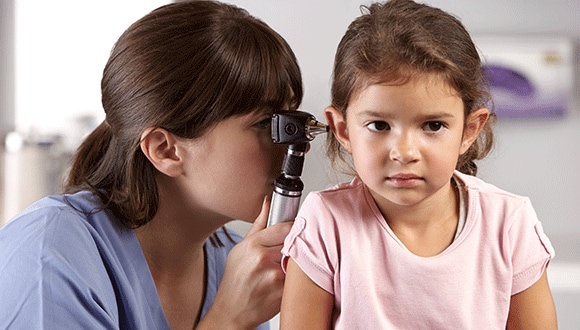Glue ear in kids
Glue ear can lead to problems with a child’s hearing, speech and behavioural development. Here’s how to treat it.
Lucy E Cousins
July 2018
Many kids get ear infections, which can cause earache and temporary hearing loss. But when these infections happen repeatedly, or if your child has ongoing hearing problems, it might be because of glue ear (also known as ‘otitis media with effusion’).
“Glue ear continues to be, by far, the most common ear condition that troubles children,” says paediatric ear surgeon Dr Phillip Chang from Sydney Children’s Hospital.

What is glue ear?
With glue ear, a sticky glue-like liquid builds up in the middle ear, which sits behind the eardrum and is connected to the nose via the Eustachian tube.
“The Eustachian tube, particularly in children, can be too short, too horizontal and too collapsible,” says Dr Chang. “So when air can’t be delivered to the ear, fluid can’t drain into the nasal cavity, and this (usually sterile) fluid builds up.”
Diagnosing glue ear
Hearing loss is often the first sign of glue ear, though some children don’t have obvious symptoms. You may also notice a change in your child’s hearing development or baby’s reactions to sounds.
Hearing impairment can result in delayed speech skills and behavioural issues if your child becomes tired and frustrated.
Other symptoms can include disturbed sleep, ringing in the ears and balance problems.
If you’re concerned that your child might have glue ear, a GP or ear, nose and throat specialist can check for fluid in their ear carry out a hearing test.
Common treatments
There are several ways to treat glue ear, and surgery isn’t always the answer. One option is a nasal balloon, where your child blows a medically designed balloon with their nose to ease pressure and clear fluid build-up in the ears.
Dr Chang says non-surgical treatment options like this are used unless glue ear is causing ongoing hearing loss and delaying speech development, or there’s a risk of damage to the eardrum.
When HCF member Tyler had recurring ear infections, he was diagnosed with glue ear.
“He would always have ear infections… they just weren’t clearing,” says his mother Kelly. It got to a point where grommets were our only answer.”
How grommets work
Grommets are small metallic or polyteflon tubes which are inserted into the eardrum, allowing the fluid to drain.
They also regulate the air pressure between the middle ear and the outer ear, restoring balance and reducing any pressure or pain in the ear canal.
Grommets surgery is done in hospital under general anaesthetic. It usually takes around 15-20 minutes, but your child will need to rest in hospital for a few hours afterwards.
Dr Chang admits the surgery can be stressful for parents and children, but he believes the benefits far outweigh the anxiety associated with it.
While it’s important for parents to understand the procedure, Kelly says her doctor was great in explaining it to her son Tyler too. She “explained everything to him in a way that he would understand”. They were then advised to go home and discuss the procedure and call the doctor if they had any questions.
After the insertion of grommets, your child may experience an immediate improvement in their hearing. They’ll have a hearing test to make sure the procedure worked.
On average, grommets fall out of the ear in earwax 6 to 12 months after the surgery, though some may need specialist assistance to remove.
Hear from HCF members who’ve had grommets inserted.
Related articles
HOW EASY IS IT TO DAMAGE YOUR HEARING?
With 1 in 7 Australians suffering from some form of hearing loss, it’s important to protect your hearing from an early age. Here’s how.
HEALTHY KIDS: KEEPING 0-5-YEAR-OLDS ACTIVE
Small children, even babies, need to be active in order to develop.
YOUR GUIDE TO IMPORTANT CHECK-UPS FOR CHILDREN
When do you take your child to their first eye test or dental check-up? Here’s what you need to know.
PREPARING YOUR CHILD FOR HOSPITAL
Here’s how to make the hospital experience less stressful for you and your child.